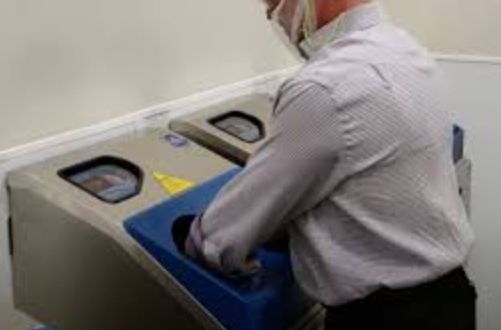
A PROJECT PROPOSAL SUBMITTED TO THE DEPARTMENT OF
MECHANICAL ENGINEERING,
IN PARTIAL FULFILLMENT OF THE REQUIREMENTS FOR THE AWARD OF NATIONAL DIPLOMA (ND) IN THE DEPARTMENT OF
MECHANICAL ENGINEERING TECHNOLOGY.
THE POLYTECHNIC, IBADAN.FEBRUARY,2021.
CERTIFICATION
This is to certify that this project proposal titled FABRICATION OF COMBINED AUTOMATED HAND-WASHING DEVICE
is carried out by:
————————————- ————————–
ENGR.OKUNLOLA G.S DATE
( SUPERVISOR)
———————————— ————————-
MR.ADETOLA .W DATE
(CO-SUPERVISOR)
———————————– ———————– ENGR. OKE D.B DATE
(HEAD OF DEPARTMENT)
DEDICATION
This work is dedicated to the Almighty God, the giver of life.
AKNOWLEDGEMENTWe are grateful to the Almighty God, the giver of knowledge and life for His mercy, protection and provision throughout the period of our programme. We wouldn`t be here without Him.
We appreciate our lovely parents for their moral, financial support and prayers. They have been wonderful and helpful during our program, may the lord protect and grant them and bless them abundantly. Amen.
We acknowledge the effort of HOD in person of Engr. OKE D.B. We extend our heartfelt gratitude to our project supervisor Engr. Okunlola G.S and our co-supervisor, Mr Adetola .W and all the lecturers in the department of Mechanical Engineering. We appreciate them all.
Our appreciation to all who have contributed for the successful completion of the proposal. Thanks to all our course mates, your continual support and trust in our abilities has not gone unnoticed. report is on the propose work titled FABRICATION OF COMBINED AUTOMATED HAND-WASHING DEVICE. The report discussed the introduction of the work, in which description of the design, fabrication and construction of the work is to be done.
TABLE OF CONTENTS
Title Page i
Certification ii
Dedication iii
Acknowledgement iv
Table of Contents v
Table of Figures vi
TABLE OF FIGURES
CHAPTER ONE: 1.1 Introduction 1.2 Research problem 1.3 Significance of the study /Expected contribution to knowledge 1.4 Objective of the study 1.5 Justification of the study
CHAPTER TWO 2.1 Literature Review
CHAPTER THREE. 3.1 Materials and Method 3.2 working and drawing
3.3 Analysis of the estimated cost of the study
3.4 Conclusion and Recommendation
3.5 Reference
CHAPTER ONE [1]. INTRODUCTION
Importance of hand washing cannot be over-emphasized, especially in developing nations where eating with hands is a common practice. In some developing cultures, there is always the reluctance of hand washing before meals; and in some, hand washing has become a culturally accepted norm. Eating with the hands was going on for generations before anyone thought of washing their hands first. So along the way, through technology and hygiene practices, people become educated in the improvement of hand washing. Hand washing is the single most important way of preventing the spread of infections, according to the US Centre for Disease Control and Prevention. Unwashed or poorly washed hands are very common way of spreading many diseases such as: cold, flu, ear infections, strep throat, diarrhea and other intestinal problems. Germs and viruses causing these diseases .Over 124 are passed on by such routine things as touching door knobs, shaking hands and putting mouths on a telephone receiver. And in our daily activities we practice one of these either in the offices, at home, in the market places, in the classroom and so on. Good hand washing practices have also been known to reduce the incidence of other diseases, notably pneumonia, trachoma, scabies, skin and eye infections and diarrhea-related diseases like cholera and dysentery, according to World Health Organization (WHO). The promotion of hand washing with soap is also a key strategy for controlling the spread of Avian Influenza (bird flu). After the incidence of SARS-Severe Acute Respiratory Syndrome in 2003, more and more people on their daily lives gave more attention to health habits; the daily number of hand-washing increased than before. This prompted us to contribute with this project as a way to increasing the practice of hand washing in our society so as to remain healthy. This machine is specially designed for use in the offices, public restroom and as well for the general domestic washing and drying of the hands at home. It supplies both soapy and clean water in a sequential order during the washing and rinsing cycle and then supplies a warm air current to dry up the completely washed hand thereof. It is handy and easy to use. More importantly, it can avoid the contagious diseases; for example, when it was a manual type hand washing machine, to turn on/off the tap, you must need the help of your hands. In this case, your hands or fingers would be infected with any virus left by any possible previous user if he or she is infected with a disease. With the automatic type, you will not only use the water at ease, but also avoid any possible contact with any contagious disease. Also some cases were considered whereby people would inevitably, more or less, waste some water as we might have seen people washing their hands at any public places or at home. It is not necessarily because people tend to waste some water at their own will, for example, when it is a traditional mechanical type, people would wash their hands under the pressed water with the switch on, as the switch is positioned at this state, the water keeps being pressed down at the same amount no matter when the person really needs the water to wash or not. This causes low efficiency of water usage. Another possibility is that people who are in a hurry may often unconsciously forget about turning the tap off, if they really forget about it, the water would keep flowing or dripping until it gets turned off by the next user. As for the automatic type, it turns on and off automatically as it senses any object with energy or heat. In this case, the unnecessary waste of water can be avoided. Therefore with all these benefits, the automatic hand washing machine are becoming increasingly popular among schools, families, dining halls, companies.
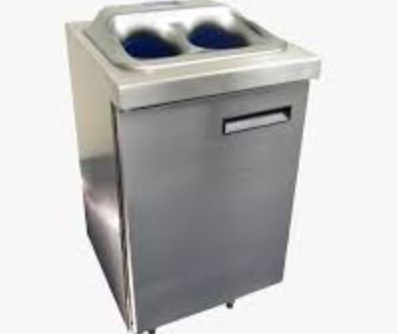
1.2 RESEARCH PROBLEM
The major problem of automated hand washing device is lack of maintenance. Other common problems existing with the device result from faulty installation, poor service procedure.
Why we are to understudy the working principle of automated hand washing device, to have in-depth understanding of the principle of operation, installation and routine maintenance of the automated hand washing device.
1.3 SIGNIFICANCE OF THE STUDY AND EXPECTED CONTRIBUTION TO KNOWLEDGE.
The significance of the study is to fabricate a automated hand washing device; and its component parts.
Some of expected contribution to knowledge are:
- To give the insight to the students on the nitty -gritty of the maintenance of a automated hand-washing device(washing, rinsing and drying)
- To broaden the students knowledge on the installation and technical know-how of a automated hand washing device (washing, rinsing and drying)
- Enlighten future readers or interested students of the working principle of a automated hand washing device production.
1.4 OBJECTIVE OF THE STUDY
The following are the objectives: - To enhance the level of hygiene wherever applicable.
- To increase the level of awareness of people as regards to the proper washing and drying of hands in accordance with the policy of the National Orientation Agency in Nigeria.
- To solve a considerable fraction of the problems associated with washing and drying of hands, so as to reduce the risk of disease transfer, between individuals.
- To expose the fact that the proper washing and drying of hands after holding objects, using the toilet and even transfer/exchanging money between individuals, will geometrically reduce the rate and/or presence of ill health in the area in question.
1.5 JUSTIFICATION OF THE STUDY
Study design and setting
A cross-sectional study was conducted among the undergraduate private university-going students in Banani of Dhaka city during August 2013–September 2013. Banani is an affluent residential area with a number of restaurants, universities, and shopping centers, as well as schools and members’ clubs, in Dhaka, the capital of Bangladesh. Out of nine private universities located in Banani, Dhaka, four nearby universities are purposively selected for this survey.
shows the results of multiple regression analysis that analyzes the effect of handwashing practice score by demographic and socioeconomic characteristics. The regression model explains 43.1% of total variations (R2=0.431). The Breusch-Pagan/Cook-Weisberg test showed that heteroscedasticity was not present in the model. Variance inflation factor test with its mean (max) value of 2.4 (4.70) indicates that there is no evidence of multicollinearity problem in the regression model.17 Ramsey regression equation specification error test (RESET) showed that there was sufficient evidence against the hypothesis of omitted variable bias in the model. Regression coefficient demonstrated that age has a negative influence on hand hygiene practice as older students had lower scores compared to the younger ones (P<0.01). On the contrary, marital status showed that the unmarried students were influencing the incensement of handwashing practice more than the married students (P<0.01). The level of higher grade education of participants had also played a significant impact on handwashing practices compared to that of lower grade education.
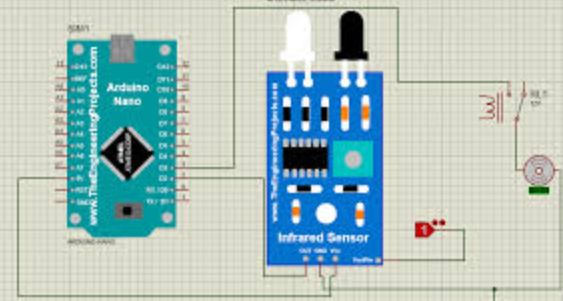
CHAPTER TWO
2.1 LITERATURE REVIEW
HISTORY OF INVENTION
Background of the Invention In 1847 Hungarian-born physician Ignaz Semmelweis made striking observations which lead to the practice of hand washing in medical clinics. While working at an obstetrics clinic in Vienna, Dr. Semmelweis was disturbed by the fact that fatal child bed (or “puerperal”) fever occurred significantly more frequently in women who were assisted by medical students, compared with those who were assisted by midwives. Through meticulous examination of clinical practices, he discovered that medical students who assisted in childbirth often did so after performing autopsies on patients who had died from sepsis (of bacterial origin). After instituting a strict policy of hand-washing with a chlorinated antiseptic solution, mortality rates dropped by 10- 20 fold within 3 months, demonstrating that transfer of disease could be significantly reduced by this simple hygienic practice.
Invention of Automatic Hand Washing Device.
Automatic hand washing device were first developed in the 1950, but were not produced for commercial use till the late 1980s when they first appeared (to the general public) at airport lavatories. Story has it that the first airport to adopt the new technology is O’Hare Airport. It is called by other names such as electronic, sensor, hands-free, touch-less or even infrared hand washing machines. Automatic hand washing machines have become a central theme in the American experience. They are now found in places, far removed from airports and other institutions, places like restaurants, hotels, casinos, malls, sports arenas as well as residential properties. Known for their assistive qualities, automatic hand washing machines are making their presence felt at living establishments and places where the elderly and or handicapped individuals call homes. Later Developments In the U.S
, issued to Johnson, entitled “HAND WASHING AND DRYING EQUIPMENT UNIT” discloses a portable hand washing and drying unit including a housing having an opening for receiving the hands of the user (the opening of the housing is closed via a door when not in use), the hand washing and cleaning liquid reservoir and electrically powered fan for providing a flow of air to dry the hands. The user manually operates a valve to dispense the cleaning liquid and manually operates a switch to turning on the fan for drying the hands. U.S. PAT No.4, 606, 085, issued to Davies entitled “HAND WASHING DEVICE” discloses an electro mechanical device that is provided with time element which are initiated by the flow of water. The hand washing device has a wash cycle and a rinse cycle and an emollient timer triggered after the rinse cycle to dispense of the emollient. Another apparatus with US PAT No.4, 398, 310 issued to Liengard entitled, “WASH STAND DEVICE” discloses a hand washing device which is triggered by light barrier. The hand washing device comprises a control system for regulating moistening, washing, rinsing and drying stages of the washing process.
Macfartane et al, discloses a machine with US PAT No. 4, 145, 769 entitled “AUTOMATIC HANDWASHING AND DRYING APPARATUS” which includes a first manually operable control device for causing operation of a solenoid operated valve to deliver hand washing water directly into a bowl for a preselected period of time. A second manually operable control device is provided for causing operation of a force air drying structure to provide hand drying air to the bowl. While each of the above hand washing and drying devices function as desired none of them are touch-less or hand free washing machine. This design operates via an infrared sensor; when the users placed his/her hands in the washing chamber without pressing any button as previous designs have one or more buttons to press, may touch the cleaning fluid (soap) dispensing device or the drying device; therefore the efforts to minimize the spread of bacteria and other diseases with the use of automated water dispensing is futile.
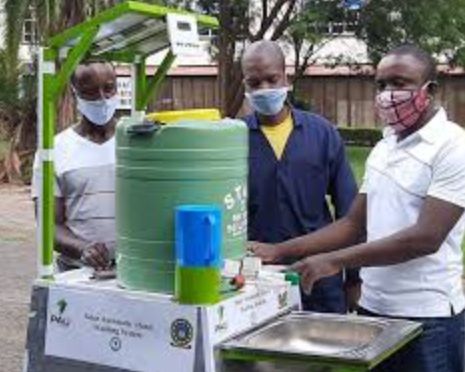
CHAPTER THREE
3.1 MATERIALS AND METHODS
The focus of the study depends on the possibility of the development and construction of a modern waste bin. The methods to be employed and to be used are design and constructions, fabrication and welding.
3.2 WORKING AND DRAWING
All the above described machines offered a guide to our own design. Our present design solves the aforementioned problems in a straightforward and simple manner. What is provided is touch-less hand washing and drying machine. The machine comprises a housing having a top portion and a bottom portion. The top portion is quasi-rectangular shaped structure comprising a fluid injection system for injecting water and fluid soap to the user’s hands. The bottom portion comprises a box shaped structure where in by the side is the heating chamber for drying the hands. The machine further comprises a wash basin coupled in the interior of said box shaped structure with circular opening under where the used water or liquid soap pass through, an electronic eye for detecting the insertion of hands in said wash basin and a control unit for timing the activation of said water injection system and said liquid soap injection in response to the detecting of said electronic eye to carry out a hand washing process. Also in the heating chamber comprising an air injection system for injecting air through said heating chamber, a thermostat to control the temperature and a sensor that activate the drying process whenever the hands cast dark shadows across it. There are also three different reservoirs, clean water reservoir, liquid soap reservoir and a waste water reservoir. The clean water and liquid soap reservoir contain two different pumps. The first pump delivers soapy water through the discharge nozzle mounted above the washing sink after which the second pump delivers clean water through the same nozzle during washing and rinsing respectively.
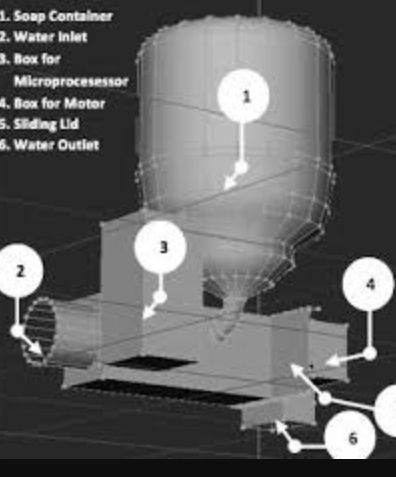
Fig. 2.1:Automated hand washing and drying device with detachable centrifugal chamber.
COMPONENTS SURVEY
The Connection Pipes The piping system are being used to channel the soapy and system from the reservoirs to the discharge nozzle for washing hand, also another connecting pipe is used to channel the dirty water to the collecting reservoir. The Blower/Fan This is the centrifugal type. It produces air current employing the use of rotating impeller. It also has a stationery casing to guide the flow of air to and from the impeller
Fig.2.2: A sketch of the centrifugal chamber THE HEATER
The heater consists of a heating filament.
The Heating Chamber
The heating chamber is the compartment that houses the heater in this chamber; there is a mixture of the heat generated by the heating filament and the air current generated by the centrifugal fan, thus producing warm air current for effective drying of the washed hands.
THE PUMP
The pumps are two in number, one for soapy water and the other is used for pumping clean water. The pumps are 12 bolts direct current electric type each. The choice of direct current type was made because it is les noisy in operation. The pumps deliver certain quantity of water from the reservoir to the washing sink at will.
THE RESERVOIRS
There are three reservoirs. Each reservoir holds an average of five liters of soapy water, clean water and dirty water. The reservoirs are made of humorplastic materials. The dirty water reservoir has a discharge port through which dirty water is discharged when it gets full.
THE SINK
The sink generally have two taps (faucets) that supply soapy and clean water and may include a spray feature to be used for faster rinsing. The sink includes a drain with a strainer.
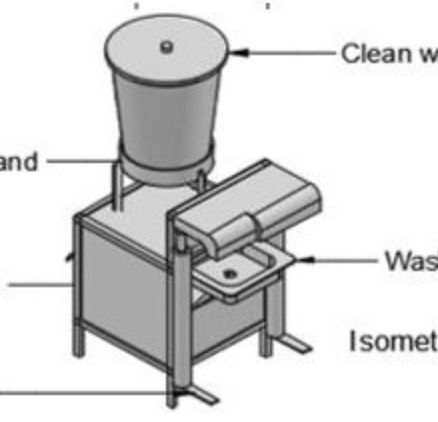
CALCULATION PARAMETERS
HEAT REQUIREMENTS
Given that the human body temperature is 37°C required drying temperature is 40°C normal room temperature is 35°C. Dimension of the heater casing is (200×200)mm heat gained or lost through the walls of the heating chamber is given by the relation. XKTA Where; = heat (watts) T = temperature difference (°C) A = external surface area (M2) K = thermal conductivity of the insulating materials (0.07 watts/meter °C) X = insulation thickness (m)
67th0=(200×10^-³ ×200×10^-³)×(0.07)×(40-35)=5.6kw. 1 25×10^-³
Electrical Connection The electrical circuit is designed in such a way that when alternating current from the power source (220 volts) mains is applied to the circuit by putting on the wall switch, the heater is on and is regulated/ maintained at 40°C by a thermostat connected to step down the voltage from 220V to 12V and then a rectifier is connected to change the current form. The fan and two pumps (soapy water and clean water pump) are connected in parallel to each other with an indicator light (light emitting diodes) connected in parallel to the fan, first pump and second pump respectively.
Electrical Connection
The electrical circuit is designed in such a way that when alternating current from the power source (220 volts) mains is applied to the circuit by putting on the wall switch, the heater is on and is regulated/ maintained at 40°C by a thermostat connected to step down the voltage from 220V to 12V and then a rectifier is connected to change the current form. The fan and two pumps (soapy water and clean water pump) are connected in parallel to each other with an indicator light (light emitting diodes) connected in parallel to the fan, first pump and second pump respectively. Electrical Connection The electrical circuit is designed in such a way that when alternating current from the power source (220 volts) mains is applied to the circuit by putting on the wall switch, the heater is on and is regulated/ maintained at 40°C by a thermostat connected to step down the voltage from 220V to 12V and then a rectifier is connected to change the current form. The fan and two pumps (soapy water and clean water pump) are connected in parallel to each other with an indicator light (light emitting diodes) connected in parallel to the fan, first pump and second pump respectly
3.3 ESTIMATED COST
s/n DESCRIPTION QTYUNIT PRICETOTAL PRICE1Water dispenser110,00010,0002Heater120,00020,0003Soap dispenser19,5009,5004Mild steel plate,1mm thickness410,00040,0005Cable2yards1,0002,0006Stainless steel 1mm thickness14,0004,0007Water storage12,0002,0008Liquid soap11,0001,0009Pump11,0001,000TOTALN 86,500
3.4 CONCLUSION AND RECOMMENDATION
This research work has successfully presented a functional and highly efficient low cost sensor-controlled hand washing and drying machine which is usable in different places within our geographical environment and settings such as hotels, homes, hospitals, executive offices, restaurants, schools etc. as way of adopting a good hand washing and drying process or procedure hence improving hygienic condition of individuals; and this eliminates the transfer of facal pathogens from one person to another.
3.5 REFERENCE
Adama, D. J. Gagge. M. et al (1992). A clinical Evaluation of Glove Washing and Re-use in Detail practice. J. Hosp. Infect.
Altermeter, W. A. (1983), Surgical Antiseptics in Disinfection and Sterilization.
American Society for Microbiology (1996) Americans Caught Dirty Handed for the Evaluation of Health Care Personnel Hand Wash Formations.
American Society of Testing Materials, Philadelphia P. A. Cengel, Y. A., Boles M. A. (1998) Thermodynamics. WCB/McGraw Hill. Engen, A. A. Theodore, B. Mark’s Standard for Mechanical Engineering (Tenth Edition). McGraw Hill. Gordon Rogers, Yon Mayhew. Work and Heat Transfer. James Carvill-Butterworth, Mechanical Engineering Handbook. Khurmi, R. S. and Gupta, J. K. Hydraulics and Fluid Mechanics. Eurasia Publishing House (P VT) Ltd New Delhi. (2003). Khurmi, R. S. and Gupta, J. K. A Textbook of Machine Design, 14th Revised Edition, Eurasia Publishing House (P VT) Ltd New Delhi. (2005). Mohanty, A.K. (1994) Fluid Mechanics. Prentice-Hall of India Private Limited New Delhi. Peter Snyder O. A. “Safe Hands” Hand wash program for Retail Food Operations. Rajput, R. K. (2005). Heat and Mass Transfer. S. Chand Company Limited. Yildiz Bayaztoglu, M. Necaji Ozisit Mechanical Engineering Series McGraw Hill International Edition. Shigley J. E. (2006) Shigley’s Mechanical Engineering Design, Eighth Edition McGraw-Hill Companies Inc.

you’re actually a just right webmaster. The web site loading speed is amazing. It sort of feels that you are doing any unique trick. Also, The contents are masterpiece. you’ve done a fantastic job on this matter!
Thanks
There are definitely numerous details like that to take into consideration. That may be a great level to carry up. I offer the ideas above as common inspiration however clearly there are questions like the one you carry up where a very powerful thing will probably be working in sincere good faith. I don?t know if greatest practices have emerged around issues like that, but I am positive that your job is clearly identified as a good game. Both boys and girls feel the impression of only a second’s pleasure, for the rest of their lives.
You should participate in a contest for top-of-the-line blogs on the web. I will advocate this web site!
Thanks… but how
It’s a pity you don’t have a donate button! I’d most certainly donate to this excellent blog! I guess for now i’ll settle for bookmarking and adding your RSS feed to my Google account. I look forward to fresh updates and will talk about this site with my Facebook group. Chat soon!
Okay 👍, I’ll appreciate such from you
Great work! This is the type of info that should be shared around the internet. Shame on Google for not positioning this post higher! Come on over and visit my website . Thanks =)
Because of you, we’ll achieve that soon ❤️
The next time I read a blog, I hope that it doesnt disappoint me as much as this one. I mean, I know it was my choice to read, but I actually thought youd have something interesting to say. All I hear is a bunch of whining about something that you could fix if you werent too busy looking for attention.
I discovered your blog site on google and check a few of your early posts. Continue to keep up the very good operate. I just additional up your RSS feed to my MSN News Reader. Seeking forward to reading more from you later on!?
Nice post. I learn something more challenging on different blogs everyday. It will always be stimulating to read content from other writers and practice a little something from their store. I?d prefer to use some with the content on my blog whether you don?t mind. Natually I?ll give you a link on your web blog. Thanks for sharing.
I was very pleased to find this web-site.I wanted to thanks for your time for this wonderful read!! I definitely enjoying every little bit of it and I have you bookmarked to check out new stuff you blog post.
I discovered your blog site on google and check a few of your early posts. Continue to keep up the very good operate. I just additional up your RSS feed to my MSN News Reader. Seeking forward to reading more from you later on!?
I am often to blogging and i really appreciate your content. The article has really peaks my interest. I am going to bookmark your site and keep checking for new information.
♥️
This is the right blog for anyone who wants to find out about this topic. You realize so much its almost hard to argue with you (not that I actually would want?HaHa). You definitely put a new spin on a topic thats been written about for years. Great stuff, just great!
Nice post. I learn something more challenging on different blogs everyday. It will always be stimulating to read content from other writers and practice a little something from their store. I?d prefer to use some with the content on my blog whether you don?t mind. Natually I?ll give you a link on your web blog. Thanks for sharing.
Oh my goodness! an amazing article dude. Thank you However I am experiencing issue with ur rss . Don?t know why Unable to subscribe to it. Is there anyone getting identical rss problem? Anyone who knows kindly respond. Thnkx
I discovered your blog site on google and check a few of your early posts. Continue to keep up the very good operate. I just additional up your RSS feed to my MSN News Reader. Seeking forward to reading more from you later on!?
very nice post, i certainly love this website, keep on it
very nice post, i certainly love this website, keep on it
It?s hard to find knowledgeable people on this topic, but you sound like you know what you?re talking about! Thanks
Thanks for another informative website. Where else could I get that type of info written in such an ideal way? I’ve a project that I am just now working on, and I’ve been on the look out for such information.
Email mail@emperorelectricalworks.com.ng
I do like the manner in which you have framed this particular concern plus it does indeed offer us some fodder for thought. On the other hand, coming from what I have observed, I just hope as the actual reviews pack on that folks continue to be on issue and not start upon a tirade of the news of the day. Yet, thank you for this outstanding point and while I do not really concur with the idea in totality, I value your viewpoint.
Okay
Fantastic website you have here but I was wondering if you
knew of any user discussion forums that cover the same topics discussed here?
I’d really like to be a part of online community where I can get opinions from other experienced individuals that share the same interest.
If you have any recommendations, please let me know.
Many thanks!
Emperor tutorials (world solving past question) on Facebook or emperor tutorials on YouTube
I don’t know if it’s just me or if everybody else experiencing issues with your site.
It looks like some of the text in your posts are
running off the screen. Can somebody else please comment and let me know
if this is happening to them as well? This might be
a issue with my web browser because I’ve had this happen previously.
Kudos
Hi! I’m at work surfing around your blog from my new apple iphone!
Just wanted to say I love reading your blog and look forward
to all your posts! Keep up the fantastic work!
Thanks friend, you can support us more
I savor, result in I discovered just what I used to be having a look
for. You have ended my 4 day lengthy hunt! God Bless you man. Have a great
day. Bye
I don’t even understand how I finished up here, but I thought this
publish used to be good. I don’t understand who you are but certainly you’re going to a famous blogger should you aren’t already.
Cheers!
Thanks
I and also my pals were found to be checking out the great secrets and techniques found on your site then the sudden developed a horrible feeling I never thanked the web site owner for them. My people are actually as a result happy to learn them and have in effect seriously been enjoying them. We appreciate you being considerably helpful and then for settling on these kinds of awesome tips millions of individuals are really eager to be informed on. My personal sincere regret for not expressing appreciation to you earlier.
Please send my farewell reading to your team.
Just desire to say your article is as astounding. The clearness in your post is just spectacular and i could assume you are an expert on this subject. Well with your permission let me to grab your feed to keep up to date with forthcoming post. Thanks a million and please continue the enjoyable work.
You’re awesome
I just like the helpful information you supply on your articles. I will bookmark your weblog and check once more right here frequently. I’m reasonably certain I will be informed plenty of new stuff proper here! Best of luck for the next!
Much thanks
Thanks for the blog post, is there any way I can get an email when you make a new article?
You’re welcome
Its like you read my mind! You appear to know so much about this, like you wrote the book in it or something. I think that you can do with a few pics to drive the message home a bit, but instead of that, this is great blog. An excellent read. I’ll certainly be back.